About the author of this page Dave is a local birder with almost 40 years’ experience who often leads groups of people with an interest in birdwatching on walks at sites around south-east London. Walking with Dave is an education because of his ability to recognise a huge variety of bird calls and to associate species with habitat and terrain. He’s been kind enough to write this page for Kent Walks Near London about the birdlife where these walks take place – in the Darent Valley, around Downe, and on the greensand ridge near Sevenoaks. Dave prefers to remain anonymous, not because he features regularly on Crimewatch or supports West Ham Utd, but through perfectly legitimate reasons too tiresome to bore you with. Look out on Friends of Beckenham Place Park’s website for details of Dave’s bird walks there.
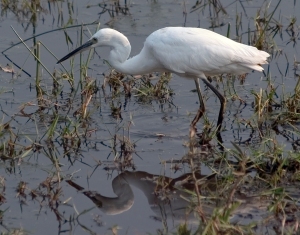
Little egret: now colonising southern England
Quite apart from relaxation, fresh air, history and greenery, these walks give us a fantastic chance to open our eyes and ears to a wonderful range of birds.
The reason so many species make this part of west Kent their home, whether breeding, wintering or just passing though, is the diversity of habitats in the area. The underlying geology – chalk, greensands (a strain of sandstone from the mid-cretaceous epoch) and clays – has influenced local land use over the centuries and the walks take you through fields of arable farming, sheep grazing, grasslands with wild flowers (such as at the Kent Wildlife Trust reserve at Fackenden Down, Shoreham), ancient and modern woodlands, Knole’s open parkland, water meadows and lakes by the Darent river, escarpment ridges, orchards, copses and old hedgerows. Such a mosaic of habitats means you are never very far from a range of interesting birds.
Rise and fall of species and landscape change
Perhaps what is most remarkable is how a slowly changing landscape, essentially medieval in origin and layout, provides the backdrop to such a dynamic mix of bird species and fluctuating populations. For instance, every walk is an opportunity to see buzzards wheeling overhead, yet 20 years ago this species was rarely recorded in London or Kent, let alone breeding near Ide Hill and Shoreham. Similarly, a walk by the Darent might reveal a dazzling white little egret, a species recently colonising Britain from southern Europe (one can often be seen from the main bridge in Shoreham village). Yet those species which colonised Britain’s first woodlands thousands of years ago, such as nuthatch, great spotted woodpeckers, goldcrests, coal tits and chaffinches are still all here today and may be found with many other species where a walk goes through ancient woodlands of oak, beech and ash and stands of pine.
The Kent Ornithological Society (KOS) bird atlases provide a fascinating picture of loss and gain over almost 50 years. Only a few years ago the Shoreham Circular walk would reveal turtle doves “purring” in spinneys and wild hedgerows but this species’ steep decline, like that of spotted flycatcher and grey partridge suggests they have all but gone from the area. But have they? Luck, weather and timing might still give walkers glimpses of the past, with recent sightings of turtle dove at Shoreham and spotted flycatchers at Igtham Mote and redstarts in the gnarled oaks of Sevenoaks’ Knole Park.
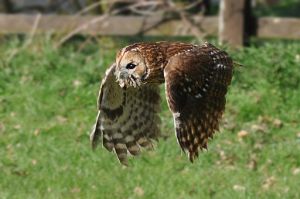
Tawny owl. Picture: Kersti Nebelsiek
The atlases and personal sightings from other walkers give a great insight to the birds of the area – 70+ species regularly use the area with 40+ regularly breeding. These include skylarks (very prevalent at Lullingstone and throughout the Darent Valley), whitethroats from Africa, bullfinches and yellowhammers (the latter often seen among fields and hedgerows around Downe and Shoreham and Otford, and on the Knockholt-Chevening walk), while a bit of luck might mean wintering finches such as siskins and bramblings – alder trees (often encountered along the Darent) might hold the former and beech the latter. Different times of day pay dividends too – try a dusk walk at Ide Hill for woodcock, or One Tree Hill, Knole and Underriver for tawny owl and little owl. The woods between Hill Hoath and Wilderness Farm on the Hever circular walk are particularly species rich. The grassland and disused golf course on walk 14, east of Shoreham, is also great habitat. Sadly, it is a long time since I saw a greenfinch on any of the walks. A once common bird that’s increasingly rare because of disease. (2024 update: I have recently seen greenfinch on the Knole walk and at Emmetts Garden on the Ide Hill walk – anecdotal reports suggest their numbers are increasing once again, I’ve certainly heard their distinct wheezing call locally in Catford and in Beckenham lately.)
Ancient woodland: is it really that old? And why’s it so special?
Ancient woodland, defined either as “ancient semi-natural woodland” or “ancient replanted woodland” is a key landscape feature of many of the walks. Although hardly primeval forests (!) these woods are pretty old and both indicate continuous wooded cover since at least 1600 and possibly much earlier.

Siskin, picture by Sławek Staszczuk
Ancient semi-natural woodland has mainly deciduous, native trees but will have been heavily managed (for example, by coppicing). It retains a complex native woodland ecosystem hundreds of years in the making. Ancient semi-natural woods at Downe, One Tree Hill and near Igtham have oaks and stands of beech and yew and patches of thick shrub layers below the tree canopy. These woods have an aura of mystery about them: in the spring and summer blackcaps seem to warble from every direction, with something approaching nightingale quality – although no one has ever written an ode to them. Blackbirds also sing brightly from these woods – but you might notice that they are much more shy than the confident birds in gardens and parks.
In ancient replanted woodland the original tree cover has been replaced or supplemented with newer plantings (although these may still be from the 19th century or after the first world war) and often includes non-native species (such as conifers). They sometimes have a more planned and regular appearance, although many plant species found in ancient woodland remain. Walks at Ide Hill, and on sections of the Otford-Romney Street-Shoreham route cross ARW. Here, walkers might hear the frantic squawks and yelps of jays as a sparrowhawk whips through the trees and woodland edges (although his is just as likely to happen in your local park in SE London), or hear coal tits singing high in the pines. One of my favourite woods is Scords, below Emmett’s Garden on the Ide Hill route. Here, the woodland has been allowed to recover on its own after the 1987 “hurricane”. Coupled with a favourable microclimate and lots of water around in the form of springs and the large Rampump pond, lots of lichen and moss has grown on the bark of trees. The health of this woods can be seen in the extraordinary number of treecreeper sightings there are here. On my most recent visit (now in February 2024) I also saw lesser redpoll (a tiny finch) and heard nuthatch. Knole Park is another walk on which a good variety of bird can be seen including stonechats in winter, redstart, siskin in winter, lesser redpoll and greenfinch.
All ancient woodland types are very important for birds and some naturalists believe a richer range of bird species exist precisely because of human interference in this habitat over the centuries. Much of the woodland around Sevenoaks, Orpington and Bromley took the brunt of the 1987 hurricane and on all the walks you can see the remains of felled trees from that wild October night. Green woodpeckers are among species that have thrived (unexpectedly) among the suddenly created glades and rotting wood of the aftermath.
Big skies
Whichever walks you take you’re sure to see or hear something that reflects the local landscape, and don’t forget the big skies and long views too – and the chance to marvel at long-range migrant swallows and house martins, finches, fieldfares and redwings passing by overhead in October. Perhaps you might get really lucky? A red kite at Otford and crossbills flying over Romney Street have been two particularly special recent migrant sightings in the area.
Whatever birds you encounter make sure you enjoy them and, if you get the chance, let others know what you’ve seen. The more birds and wildlife we discover on these walks the richer they become and will help us all enjoy and value this marvellous countryside so close to London.
Want to know more?

Yellowhammer: often seen in hedgerows and field edges on these walks
A fascinating database of habitats is maintained by NaturalEngland – try the MAGIC site and zoom in on west Kent for some very detailed maps giving specific descriptions of terrain types (who knew that Knole Park was rare ‘lowland dry acid grassland‘?). Paul Morrison’s Bird Habitats of Great Britain and Ireland: a new approach to birdwatching, although a little dated, is also a good introduction to the subject, as is Rob Fuller’s Bird Habitats in Britain. For more information on ancient woodland visit the Woodland Trust.
You can also find out more about the birds of the Kent/London borders by visiting the Kent Wildlife Trust, Kent Ornithological Society and London Natural History (London Birdclub) websites, where you can also look for recent bird sightings or report your own. The KOS sightings site for Sevenoaks Wildlife Reserve is one of many offering recent, sometimes daily sightings.
Adam’s five personal favourite bird encounters on these walks
Redstart – with Dave’s help that one, in Knole.
Tawny owl – I never usually see them, although they aren’t rare, but saw two together at Knole Park, one at One Tree Hill and one on the woodland fringe near the final field of the Downe circular – all in 2016. Very often heard in most of the woodland on these walks around dusk.
Woodcock – on the Eynsford/Lullingstone route. It flew up from grassland a few feet ahead of me and my sons and circled us for a minute, somewhat haphazardly.
Kingfisher – Underriver walk at the pond below St Julians. Also often seen along River Darent, in its quieter stretches.
Crossbills – with Dave’s help near Romney Street; several flew overhead, September
Buzzards – not rare, but I’ve got very close to a pair of these gorgeous birds at Point 2 on Walk 14 (Shoreham east). Buzzards can be seen on all the walks. Polhill and Meenfield woods is good for them particularly, as is Fackenden Down where they enjoy the rising thermals.
My all-time favourite bird sighting was not on these walks but near Brockley train station, on the pedestrian bridge in 2013, when a red kite glided a few feet over my head. Also in 2013 I had a similar encounter on a high mountain ridge in north-west Scotland, but this was a sea eagle flying beneath us, not a kite.
I’ve also experienced a sparrowhawk swooping so close to my head that I sensed the disturbed airflow around my ear before seeing it. A small flock of sparrows was its intended prey. They got away, escaping into a bush. This was not in the countryside but in trafficky and concrete Bell Green, Lower Sydenham! Since then I’ve seen sparrowhawk twisting at high speed between cars and buses on the South Circular near Blythe Hill, again in pursuit of a small bird. Beckenham Place and Mayow Park are often on sparrowhawks’ rounds, as is the River Pool Linear Park.
Short-eared owl – another from Romney Street where there are many fallow fields as I write in early 2019. This bird was hunting low over the rewilding meadows in early February. On the same walk, the Fackenden Down route, we heard linnets and goldcrests (we were hoping for a firecrest) and saw bullfinches and coal tits.
Red kite – on the Downe cycle at Grays Rd; very low. Red kites are now common on all the walks – you should feel disappointed if you haven’t seen one! They particularly like the escarpment updrafts, like buzzards so head to Knockholt-Chevening, Fackenden Down, and Heaverham/Kemsing for a good chance of a flyby.
Yellowhammer – on the Pilgrims’ Way road, near Brasted Hill.
Hobby – in July 2019 I watched two hobbies teaming up to hunt swifts above Beckenham Place Park. The same summer a hobby, one of the same birds probably, was seen repeatedly swooping on sparrows by the river Pool at Selworthy Rd.
Lesser redpoll – at Knole and at Scords wood on the Ide Hill walk.
Wheatear – in April on the Ide Hill walk.
Kent Wildlife Trust reserves close to or on the walks on this site
- Bough Beech
- Downe Bank
- Fackenden Down
- Hewitt’s Chalk Bank
- Kemsing Down
- Ivy Hatch
- Polhill
- Sevenoaks Wildlife Reserve
- The Warren (nr St Mary Cray)
- Also worth a visit is the excellent High Elms Country Park visitor centre near Downe and Orpington on the site of John Lubbock’s (friend of Darwin’s) old house
Birds on the walks spring 2021
By Dave
Longer, sunnier, warmer days see a marked uptick in activity: birds suddenly seem more obvious and pronounced in the landscape and along all the walks at KWNL, becoming more showy and vocal as for many species the breeding season begins.
Longer, sunnier, warmer days also mean the locals are joined by summer migrants from the south, some to stay and nest while others hurry through, rarely lingering for long as they push north into the UK or beyond, perhaps passing in transit the redwings and fieldfares going the other way, heading for Scandinavia by late March and early April.
The British Trust for Ornithology has overseen three nation-wide breeding bird surveys over the past 50 years producing atlases showing the changing distribution of different species. There have been notable winners and losers in SE England as the Kent area atlases reveal. Back in 1970 a local walk might mean meeting colourful turtle dove on most spring and summer trips, whereas now the species is hurtling towards extinction in the UK and a very lucky find locally – though perhaps clinging on around Shoreham and Romney Street?
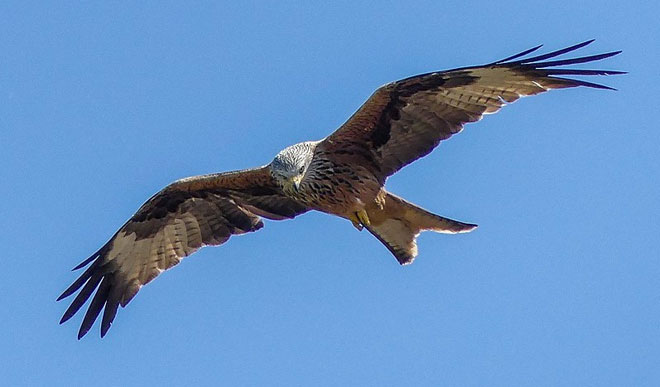
Spectacular red kite are being seen more often on the walks but are still nothing like as common as they are in areas of Berkshire and Oxfordshire. Photo: Wikimedia Commons
If you see one let local wildlife authorities such as the Kent Wildlife Trust or Kent Ornithological Society know because this species is a subject of a survey in Kent this year. More positively, the sight of buzzards circling on thermals today (with 700+ confirmed or possible breeding locations in Kent by 2014) would have been astonishing in the 1970s when it was not recorded as a breeding species at all, and at only six locations by the early 1990s!
The changing breeding bird communities, together with spring migrants, mean every one of the walks will produce interesting and charismatic bird species with splashes of colour and lovely, evocative songs. The blend of landscape and habitats that characterise the walks – ancient woodland, scruffy hedgerows, ponds, rivers, grassland – will certainly favour some species more than others, and big skies and long views gives a good chance of seeing more aerial birds. Three birds of prey species might be especially obvious and well worth watching at length should you meet them: buzzards, kestrels and red kites.
The common buzzard population explosion is a great success story (unless you are a rabbit). In spring, typically on sunny warm days, you might become aware of faint or distant “meewing” look up and you might see two, three or sometimes up to eight buzzards circling and displaying, sometimes reaching great heights. Even if they are invisible to us they will be able to see you – with vision eight times better than ours. Buzzards can now be seen on all of the Kent Walks near London, particular on walks along escarpments where soaring birds enjoy the uplift of air – so Fackenden Down, One Tree Hill, Ide Hill, Knockholt/Chevening are all prime buzzard territory.

Male kestrel. Photo: Wikimedia Commons
Kestrels are much smaller, pigeon-sized birds of prey, and as falcons perhaps nearer parrots in the evolutionary tree than buzzards. Kestrels can be quite noisy with high pitched, harsh, excitable calls during the breeding season or if there are young birds about, but when they are hovering, eyes down scanning the ground, they are silent masters of concentration, subtly shifting their fanned tails against the wind.
Although they don’t always hover when hunting (often watching from low in trees and just dropping silently on to prey as it emerges from nearby grasses or hedgerows as seen at Lullingstone), this can be a great chance to watch them closely: binoculars reveal their subtle colours, including cinnamon, rust and blue-grey. Kestrels can be seen on most of the walks, especially Shoreham’s grassland, fields and woodland edges hunting worms, beetles, mice, voles and small birds.
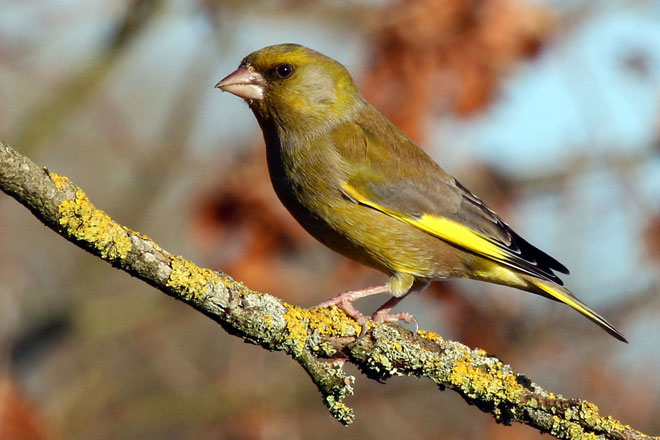
Once common, now rare but perhaps making a comeback – a greenfinch. Photo: Charles J. Sharp/Wikimedia Commons
Other migrants through the area are much, much smaller but come amazing distances. Midnight-blue swallows and house martins, although much reduced in number in the past decade, can be seen racing and swirling over many walks in April-June, especially with water nearby such as at Bough Beech, and the Darent valley walks, with the latter still nesting at Eynsford. Another African migrant species worth keeping an eye for in stony, open fields or areas of short grass, especially after April showers or overnight rain are stunningly beautiful wheatears. Although smaller than starlings, wheatears, like swallows fly from southern Africa to northern Europe with some going further to the Arctic. They might stay for a day or two at most before heading on, and in recent years the Knole Park walk golf course has regularly produced these birds.
Chaucer wrote of April bird song but it reaches a crescendo in early May, when a dawn chorus can be a deafening mix of migrants and locals. The rolling songs of chaffinches, wheezing greenfinches and tinkling linnets and goldfinches can be heard along many KWNL routes, with One Tree Hill towards Ightham Mote particularly good sites.
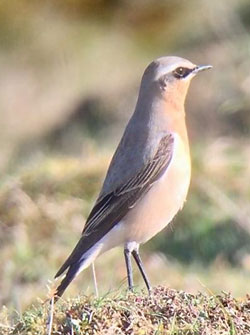
Male wheatear at Knole this spring. Photograph: James King
Where the walks involve woodland and scrub such as Downe, Petts Wood and Chiddingstone strong songster such as blackbirds and song thrush will be pitted against the fantastic intricate high speed warbles of summer migrant blackcaps and perhaps garden warblers – both species very hard to see but lovely to hear.
And what about nightingales on the KWNL? The epitome of a spring migrant to southern England woodlands in by-gone times, nightingales still occur in tiny numbers: try the Bough Beech reservoir walk on sunny May evenings for these amazing songsters – a bird certainly worth stopping to listen to!
Whatever birds you meet on the KWNL take your time to watch, listen and enjoy them and their busy spring-time lives, whether local cooing wood pigeons or migrant chiffchaffs singing from the tree tops for a few months before they turn to the south once again.
Birds on the walks December 2018-May 2019
The birds found in and around the walks area over the winter were an exciting and interesting mix, and it goes to show just what you might find – or what might find you – on one of these strolls.
The walk at Downe produced a merlin in December – this tiny dashing falcon seen by the golf course 13th Green. The Darent river area walk saw 20+ bramblings in January, with a flock of 57 skylark and a stonechat in nearby Otford. Other exciting birds in the Shoreham/Otford/Polhill walks areas in Jan-March included peregrine, wigeon, Egyptian goose, a green sandpiper and a red kites.
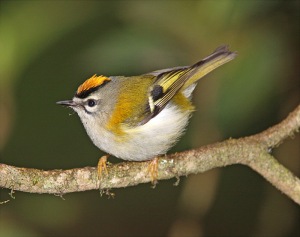
Firecrest
The latter species was also seen in the Chiddingstone/Penshurst walk area in March (where there had been an amazing flock of 1,000 wood pigeon in December) and over Knole Park. The walk there had 30 redwings in December, stonechats, and lesser redpolls, brambling, nuthatch, kestrel and bullfinch and a ring ouzel and a singing firecrest in early April. This tiny bird is the joint smallest (with goldcrest) European bird and one of the most beautiful. Other firecrests turned up by the Petts Wood and Chislehurst walk in January and March, where there was also a Mandarin duck. This species originates from China but is now so scarce there that the small UK population (derived from escapees over the last 100 yrs) is now of international conservation importance. A short-eared owl was the star bird on the Fackenden Down/Shoreham walk in February, where there was also a tawny owl and 150+ Jackdaws. Another owl – a barn owl – was in the Westerham/Chartwell walk area in March, with the very rare lesser spotted woodpecker there in January.
The Bough Beech-Bore Place walk is probably the best walk for birds – but you will definitely need your binoculars and a telescope to get the most of this site. This winter the walks area produced great northern diver, marsh tit, 26 goosesander, fieldfares, barn owl, raven, 30 great crested grebe and a flock of 16 grey herons in flight together. April saw some early migrants here too, including cuckoo, swallow, a pair of cranes and a tiny wader – the little ringed plover which hopefully will stay to breed! Another rarity – turtle dove – was singing near One Tree Hill in May, and this month also saw swifts back in Sevenoaks and blackcaps, chiffchaffs and a few garden warblers in the local woods.
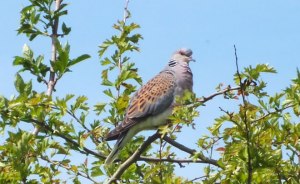
Turtle dove © Peter Pearson
Spring and early summer provide lots of opportunities to see and hear many birds on the walks, with resident species joined by summer migrants. Look out for swallows zipping through the valleys at Shoreham or house Martins at Eynsford as well as swifts over Downe, and perhaps, if you’re very lucky, turtle doves around Romney Street, and maybe cuckoo at Hever-Chiddingstone-Penshurst, or Bough Beech, and the strange “churring” song of the nightjar near Ide Hill. And because the birds are in full song listen out for the bright warble of the blackcap coming from woodland walks, as well as the chiffchaff’s metallic, echoey zip-zap, zip-zap (or ‘chiff chaff, chiff chaff’) from the tops of the trees.
The chiffchaff is now quite common but 30-40 years ago it was hugely outnumbered by the willow warbler, an almost identical species and then one of the commonest in the UK. Now, however, the quiet almost apologetic song of the willow warbler is rarely heard on any of the Kent Walks Near London and the decline probably reflects its populations shifting northwards in response to climate change.
Birds on the walks: autumn and winter 2016-17 update (by Dave)
The birds found on in the vicinity of over the autumn and winter were an exciting and interesting mix, and it goes to show just what you might find, or what might find you on one of these strolls.
Although birds in woodland in the summer are not always easy to see, with many moulting and keeping a low profile, by autumn many adult and juvenile birds are on the move and there is every chance of running into small flocks of finches and tits. As the autumn of 2016 progressed, and the trees lost their leaves woodpeckers, nuthatches and treecreepers became more obvious, and the tiniest European birds – the Goldcrest and the much rarer Firecrest – were all encountered. These usually give themselves away by their thin, short high-pitched calls, so high pitched in fact as to be a challenge for more elderly ears, and numerous goldcrests and the odd firecrest were noted on Petts Wood and Chistlehurst walks. Goldcrests will nest in conifers in the spring, so when walking in Ide Hill, Knole Park and Downe listen out for these minute birds singing their short tinkling song, almost imperceptibly from the dark pines.
Many goldcrests and most firecrests are migrants, and among those departing or arriving in our walks area this autumn were swallows and house martins, with wheatears and even a hen harrier at Otford, and a woodcock at Petts Wood. Later in the autumn buzzards, meadow pipits, skylarks and grey wagtails were all encountered, many of them European birds. Some species were pretty thin on the ground however – if anyone caught up with redpolls or siskins along the river Darent on the Lullingstone walks let Adam know (editor – no need, I saw siskins there!).
Much commoner and obvious were migrant winter thrushes – fieldfares and redwings. Most will be heading back to Scandinavia by April but there were redwing flocks of 200+ at Chislehurst and 500+ at Petts Wood, while big flocks of fieldfares were noted near One Tree Hill, where two marsh tits were also seen.
Looking ahead – spring and summer
Spring and early summer provide lots of opportunities to see and hear many birds on the walks, with resident species joined by summer migrants. Look out for swallows zipping through the valleys at Shoreham –last year’s survivors back from southern Africa – as well as swifts over Downe, and perhaps, if you’re very lucky, turtle doves around Romney Street. And because the birds are in full song listen out for the bright warble of the blackcap coming from woodland walks, as well as the chiffchaff’s metallic, echoey zip-zap, zip-zap (or ‘chiff chaff, chiff chaff’) from the tops of the trees. Both these summer migrant warblers are quite common but although the songsters can probably see you, you will struggle to see them among the leaves.
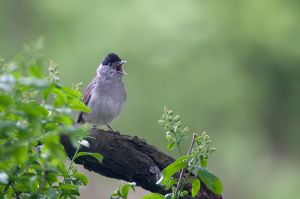
Blackcap
A few walks, including those around Romney Street, Eynsford and Shoreham might see you bumping into yellowhammers, a species declining in the UK. These canary-yellow birds about size of a sparrow have a famous nasal-toned song, often transcribed as “A little bit o’bread and no cheese” with a wheeze on the “cheese”! So, your best bet of finding one of these is around lunchtime and not too far from one of the local pubs.
Want to know more? Check out the RSPB and British Trust for Ornithology (BTO) website sites for information on different species, and the xeno-canto.org site for songs. Bird sightings from the Kent Walks near London area sometimes feature on the Kent Ornithological Society and London Bird Club wiki news websites.
What birds have you seen or hear on the Kent walks near London? Don’t forget to comment and let everyone know. Also, you can go to the Facebook page for this site and share your bird sightings there.

Donations
If you’ve enjoyed one of the walks on this site and feel it’s enriched your day, feel free to make a small donation here if you wish. It'll encourage me to add more walks, update information and work harder to improve accuracy and quality. Thanks a lot.
£3.00

Hi anonymous Dave. I looked at the link to Beckenham Place Park and realised that we both used to be members of the Bromley YOC back in the 80’s! I still live in Bromley and it seems as if we go walking sometimes in similar places (I particularly like Polhill Bank). You have my email address now if you ever want to get in touch.
Jon
LikeLiked by 3 people
Hi Jon, I will pass your message on to anonymous Dave. There may be hobbies nesting in BPP I believe – I’ve certainly seen a pair there. Also buzzards increasingly dropping by. Thanks for writing in.
LikeLiked by 1 person
Yes, it was a report of the Hobby’s breeding at BPP that got me looking on the website!
LikeLiked by 1 person
Also sparrowhawks nesting in the area. Often seen hunting at BPP
LikeLiked by 1 person
Saw a blackcap, long tailed tits and two buzzards on Sept 14 on walk 14 (Shoreham’s eastern valleys). Numerous kestrels too. Kingfisher flew past me on Darent river that day too… near Eynsford. Treecreeper spotted in the woods above Shoreham (on several of the walks on this site) and nuthatch too. Tawny owl at Downe also seen, sitting on a fence on Cudham Hill.
LikeLiked by 2 people
Hello Son of Yossarian, thanks for letting us know about your sightings – these are all good birds to see, and a real mixture too! Blackcaps wont be singing by September and by the end of the month are getting very thin on the ground as many will have migrated. It’s always nice to see Long tailed tits, and in early autumn gangs of them, sometimes of 30+ (!) roam the hedgerows and woodland edges in many of the areas covered by the walks. Hopefully all the sightings of Tawney Owl, Kestrel and Buzzard reflect a good breeding season for local avian predators, while the Nuthatches and Treecreepers you found above Shoreham will probably be in some of the older mixed woodland. I hope you get a chance to go on a few walks over the winter – ones by the Darent are likely to provide more Kingfisher sightings,as well as Grey Wagtails, and possibly Little Egret and Grey Heron – and any walks with stands of Beech beech trees might produce flocks of Brambling, a Scandinavian finch which can be very scarce some years and commoner the next, and this year they certainly seem more plentiful!
LikeLiked by 1 person
Could I have seen a buzzard bear shoreham airport ?
LikeLiked by 2 people
Hi Sue, absolutely! Buzzards now breed in the area and across SE England and can be seen soaring and circling.
LikeLiked by 1 person